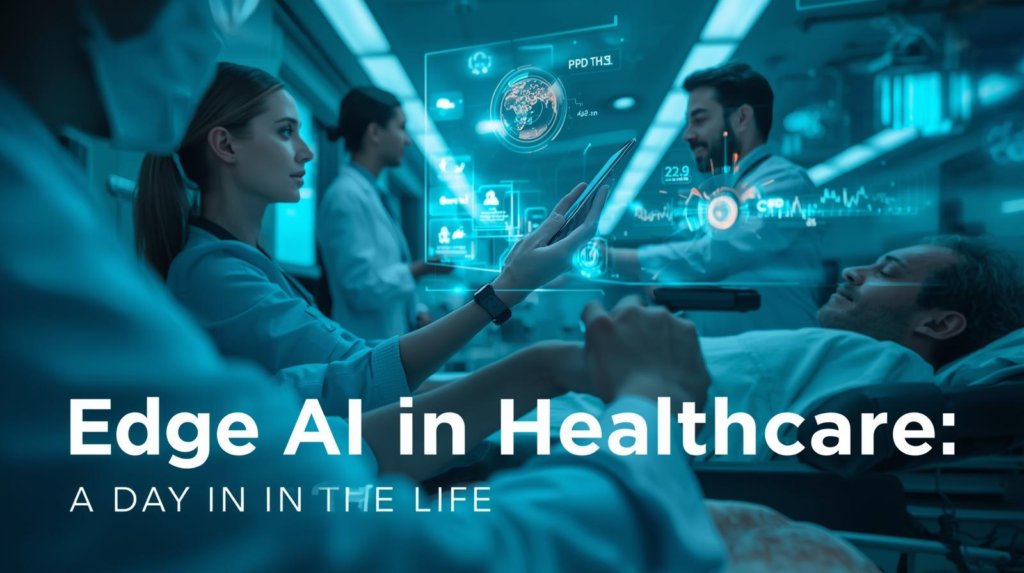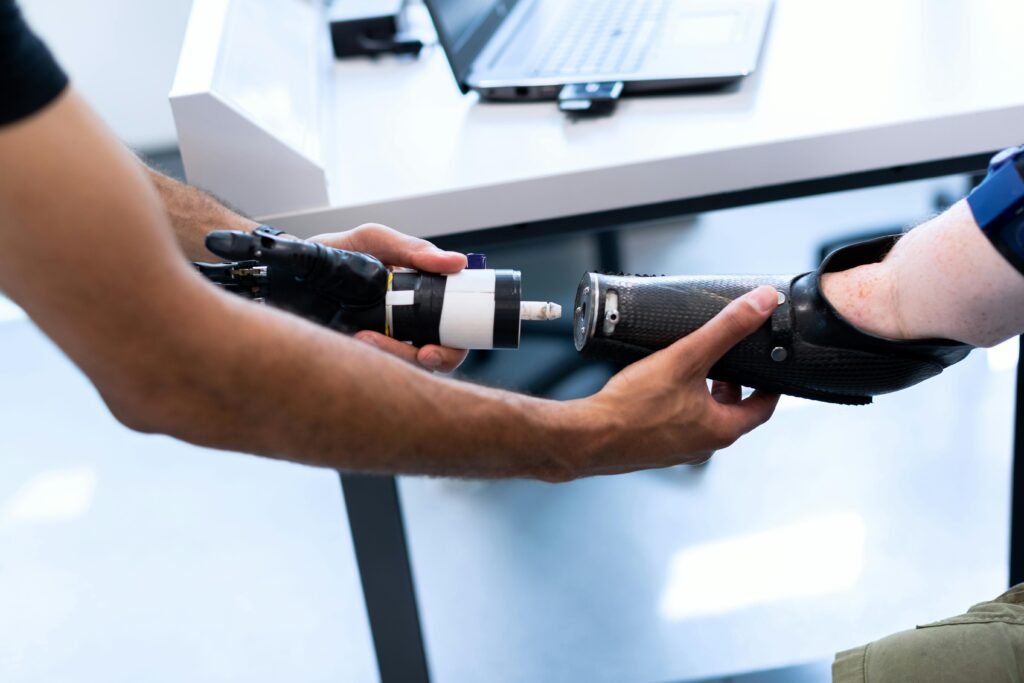
Imagine waking up in a world where medical decisions are made in seconds, life-saving diagnoses don’t depend on internet connectivity, and privacy concerns around medical records are nearly eliminated. That world is no longer a futuristic dream—it is already unfolding today with edge AI in healthcare.
In this narrative, we’ll step into the shoes of a physician, patients, and rural healthcare workers to understand how edge AI in healthcare applications are revolutionizing medical practice. At AixCircle, we believe these stories highlight how technology can humanize medicine while empowering doctors to deliver better outcomes.
7:00 AM – A New Beginning for Doctors
It’s early morning in Bangalore. Dr. Meera, a general physician, enters her clinic. Instead of logging into a desktop computer or sorting through paper charts, she simply puts on her AI-enabled augmented glasses. These glasses connect seamlessly with edge AI in healthcare devices installed in the clinic.
Unlike traditional cloud-based systems, edge AI in healthcare processes data locally. This means patient vitals, ECG readings, and scans are analyzed right there in the clinic, without depending on internet speed or remote servers. The result? Faster, more reliable insights, giving Dr. Meera more time to focus on care rather than technology.
This is where the machine learning process explained in healthcare becomes critical. By training models on thousands of ECGs, glucose levels, and patient histories, the AI can instantly match patterns and provide actionable recommendations.
Patient Check-In: Data at the Doorstep
As patients walk in, their wearable devices sync with the clinic’s edge servers. Heart rate, blood pressure, oxygen saturation, and glucose levels are transmitted in real-time. Instead of waiting for lab reports or connecting to a cloud server, edge AI in healthcare applications provide immediate insights.
One patient, a 35-year-old woman with diabetes, doesn’t need to explain her condition. Her wearable sends continuous glucose monitoring data to the edge device, which alerts Dr. Meera about unusual sugar fluctuations over the past week. This proactive approach prevents emergencies by addressing patterns early.
This is the data-driven AI revolution in practice. Just like cities build digital twins, clinics are now building digital replicas of patients’ health profiles—continuously updated and locally stored for faster interventions.
Diagnosis in Seconds: Life on the Line
At 9:30 AM, an elderly patient walks in, complaining of mild chest discomfort. Traditionally, he might have been sent for a lab ECG, then asked to wait for hours. But with edge AI in healthcare, the process is instant.
Dr. Meera places sensors on his chest, and within 3 seconds, the AI system flags the likelihood of an early-stage cardiac arrest. The local edge device compares his ECG against thousands of cases, all processed right there in the clinic.
No internet lag. No delays. Just real-time AI healthcare applications saving a life.
This is where neural networks in healthcare shine. By mimicking the human brain’s ability to recognize patterns, they identify subtle abnormalities invisible to the human eye. What used to take labs and cardiologists hours to confirm is now available to general practitioners in real-time.
Remote Rural Care: Breaking the Connectivity Barrier
Meanwhile, hundreds of kilometers away in a rural village, a health worker uses a portable handheld scanner. The device is powered by the same edge AI in healthcare framework. Even in areas with weak or no internet connectivity, it can process medical scans locally.
A child with a persistent cough undergoes a lung scan, which instantly detects signs of pneumonia. The system advises immediate antibiotics, preventing a serious escalation.
For rural communities where access to specialized doctors is scarce, this technology is a lifeline. It ensures that AI gold rush trends in healthcare benefit not just urban populations but also the underserved.
This is a true example of human-AI coexistence—technology amplifying human expertise, not replacing it.
Privacy as a Priority
In today’s digital era, patients often worry: Who has access to my medical records? With cloud-based systems, there’s always a fear of hacking or misuse of sensitive health data.
Here, edge AI in healthcare plays a game-changing role. Since patient data is processed and stored locally on edge devices, it never has to leave the clinic or hospital. Patients feel reassured knowing their records aren’t floating in an unsecured cloud.
This feature aligns with growing global calls for ethical AI healthcare systems that balance innovation with patient rights. By embedding privacy at the core, AixCircle believes edge AI healthcare applications will see faster adoption.
Afternoon Workload: Scaling Efficiency
By 2:00 PM, Dr. Meera has already treated 30 patients. In the past, this would have been impossible—long lab queues, report delays, and endless documentation slowed her down.
Now, edge AI in healthcare devices handle routine tasks:
- Automated triage: Patients are categorized by urgency based on vital readings.
- Predictive insights: AI predicts which patients may develop complications in the near future.
- Decision support: Suggestions on medications, lifestyle changes, and referrals are automatically provided.
This isn’t about replacing the doctor—it’s about making her AI intelligence-powered partner more effective.
The Bigger Picture: A Future with Edge AI in Healthcare
The benefits of edge AI in healthcare applications extend beyond one clinic:
- Hospitals: Edge systems reduce dependency on internet bandwidth during peak loads.
- Smart Cities: Health kiosks with AI-powered smart society healthcare devices can provide diagnostics in public spaces.
- Disaster Zones: Mobile edge devices can offer on-the-spot treatment during floods, earthquakes, or pandemics.
By 2040, imagining daily life with AI integrated into society by 2040 may include edge AI healthcare devices in every household—scanning, predicting, and preventing diseases long before they escalate.
Challenges to Overcome
Of course, the journey isn’t without obstacles:
- Cost of Implementation: Installing edge devices can be expensive initially.
- Training Needs: Doctors and nurses must be trained in using edge AI healthcare systems effectively.
- Interoperability: Devices from different vendors need to communicate seamlessly.
But as with the internet and smartphones, costs are expected to decline as adoption increases. The real challenge is building trust in AI healthcare applications—and that’s where transparency and ethical practices will play a key role.
7:00 PM – The Day Ends, but the Revolution Continues
By evening, Dr. Meera has seen 50 patients. Each diagnosis was faster, more accurate, and backed by edge AI in healthcare systems. She reflects on how much has changed since she first became a doctor.
For her, AI isn’t a replacement—it’s a silent partner in healthcare, ensuring every patient gets the best possible care. For patients, it’s the assurance that technology is working for them, not against them.
As she removes her augmented glasses, she knows tomorrow will bring new challenges—but also new possibilities. Because with edge AI in healthcare, medicine isn’t just evolving—it’s leaping forward.
Conclusion
The story of Dr. Meera and her patients is not science fiction. It’s already happening in pilot projects across the globe. From urban hospitals to rural villages, edge AI in healthcare applications are proving that medicine doesn’t have to wait for the cloud to respond.
At AixCircle, we see edge AI in healthcare as the bridge between advanced technology and human empathy. It’s not just about faster diagnostics or cost efficiency—it’s about creating a human-AI coexistence in healthcare where doctors and technology work hand in hand to save lives.
The future isn’t just about AI gold rush trends or futuristic predictions—it’s about the quiet revolutions already taking place in clinics like Dr. Meera’s. And as adoption grows, one thing is certain: the data-driven AI revolution in healthcare is here to stay, and edge AI in healthcare will be at its heart.

